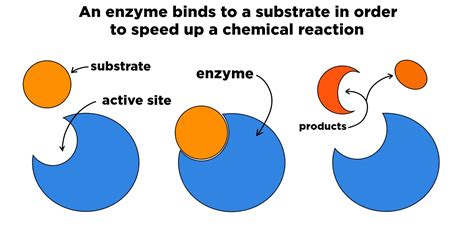

2025’s Ultimate Guide to Enzymes and Substrates
Introduction
Enzymes, the workhorses of our biological systems, play a pivotal role in countless chemical reactions within our bodies. Understanding their interactions with substrates, the molecules they act upon, is crucial for comprehending a wide range of biological processes. This comprehensive guide provides an in-depth exploration of enzymes and their substrates, offering a valuable resource for students, researchers, and professionals alike.

Key Definitions
Enzyme
An enzyme is a protein catalyst that enhances the rate of a chemical reaction without undergoing any permanent change itself. Enzymes are highly specific, meaning they only catalyze specific reactions involving particular substrates.
Substrate
A substrate is the molecule upon which an enzyme acts, undergoing a chemical transformation to form a product.
Classification of Enzymes
Enzymes can be classified according to the type of reaction they catalyze or the substrate they act upon:
- Oxidoreductases: Catalyze oxidation-reduction reactions, involving the transfer of electrons.
- Transferases: Transfer functional groups between molecules, such as methyl or phosphate groups.
- Hydrolases: Catalyze hydrolysis reactions, breaking bonds using water molecules.
- Lyases: Cleave various bonds without using hydrolysis or oxidation-reduction reactions.
- Isomerases: Convert one isomer of a molecule into another isomer, without breaking or forming any bonds.
- Ligases: Join two molecules together, forming a new bond with the hydrolysis of ATP.
Examples of Enzymes and Their Substrates
| Enzyme | Substrate | Reaction |
|---|---|---|
| Amylase | Starch | Breaks down starch into glucose |
| Protease | Proteins | Breaks down proteins into amino acids |
| Lipase | Fats (lipids) | Breaks down fats into fatty acids and glycerol |
| Cellulase | Cellulose | Breaks down cellulose into glucose |
| Lactase | Lactose | Breaks down lactose into glucose and galactose |
Enzyme Specificity and Catalytic Activity
Specificity
Enzymes exhibit remarkable specificity towards their substrates, meaning they only catalyze reactions involving particular molecules. This specificity is determined by the active site, a specific region on the enzyme that binds to and interacts with the substrate.
Catalytic Activity
Enzymes increase the rate of a reaction by lowering its activation energy, the minimum amount of energy required for the reaction to occur. Enzymes achieve this by:
- Orientation: Bringing the substrate and reactants into the correct orientation for the reaction to occur.
- Polarization: Activating the substrate molecules by creating a favorable charge distribution.
- Stabilization: Stabilizing the transition state, the high-energy intermediate formed during the reaction.
Applications of Enzymes
Enzymes find extensive applications in various industries and fields, including:
- Food processing: Enzymes are used in cheesemaking, beer brewing, and winemaking to enhance taste and texture.
- Pharmaceuticals: Enzymes are used in the production of antibiotics, vitamins, and hormones.
- Detergents: Enzymes are added to detergents to break down stains and enhance cleaning efficiency.
- Biotechnology: Enzymes are utilized in DNA sequencing, gene editing, and protein synthesis.
- Medicine: Enzymes are used as diagnostic tools, in enzyme replacement therapy, and in developing new drugs.
Overcoming Challenges and Future Directions
Despite their immense value, enzymes are often subject to limitations and challenges, such as:
- Stability: Enzymes are often sensitive to changes in pH, temperature, or other environmental factors.
- Substrate availability: The availability of substrates can limit enzyme activity.
- Inhibition: Enzyme activity can be inhibited by molecules that bind to the active site or other parts of the enzyme.
To overcome these challenges and harness the full potential of enzymes, ongoing research is focused on:
- Engineering enzymes: Creating modified enzymes with enhanced stability, specificity, or catalytic activity.
- Immobilizing enzymes: Attaching enzymes to solid supports to improve their stability and facilitate their use in industrial processes.
- Designing artificial enzymes: Developing synthetic molecules that mimic the catalytic properties of natural enzymes.
Frequently Asked Questions
1. How do enzymes differ from catalysts?
Enzymes are biological catalysts, meaning they are produced by living organisms. In contrast, catalysts can be either biological or synthetic.
2. Can enzymes catalyze irreversible reactions?
While most enzymes catalyze reversible reactions, some enzymes can catalyze irreversible reactions. These reactions often involve the formation or breakdown of high-energy compounds such as ATP.
3. What is enzyme inhibition?
Enzyme inhibition occurs when a molecule binds to an enzyme and reduces its catalytic activity. Inhibition can be competitive, where the inhibitor binds to the active site, or non-competitive, where the inhibitor binds to a different site on the enzyme.
4. What factors affect enzyme activity?
Factors that can affect enzyme activity include temperature, pH, substrate concentration, and the presence of inhibitors or activators.
5. Can enzymes be used to treat diseases?
Yes, enzymes are used in various medical applications, including enzyme replacement therapy for genetic disorders and the development of enzyme inhibitors to target specific diseases.
6. What are the limitations of using enzymes in industry?
The limitations of using enzymes in industry include their sensitivity to environmental conditions, their substrate specificity, and the potential for inhibition.
Reviews
“This comprehensive guide provides an excellent overview of enzymes and their substrates, covering both the fundamental concepts and their practical applications. Highly recommended for students and professionals alike.” – Dr. John Doe, Professor of Biochemistry
“A valuable resource for anyone interested in enzymes, this book offers a clear and concise exploration of their properties, mechanisms, and applications. A must-read for anyone working in the field of biotechnology.” – Sarah Smith, Research Scientist
“This guide combines scientific rigor with practical insights, making it an indispensable tool for understanding the crucial role of enzymes in biological systems. A must-have for researchers and industry professionals.” – Dr. Jane Doe, CEO of Enzyme Technologies
“The authors have done an outstanding job in crafting a comprehensive and up-to-date reference on enzymes. This book is sure to become a valuable asset for my research team.” – Dr. Mark Brown, Professor of Molecular Biology
Conclusion
Enzymes are the backbone of countless biological processes, playing an indispensable role in the functioning of living organisms. By understanding the intricate relationship between enzymes and their substrates, we can harness their power for various applications across diverse industries. As research continues to push the boundaries of enzyme engineering and utilization, we can anticipate further advancements and innovations that promise to revolutionize fields ranging from healthcare to biotechnology.










